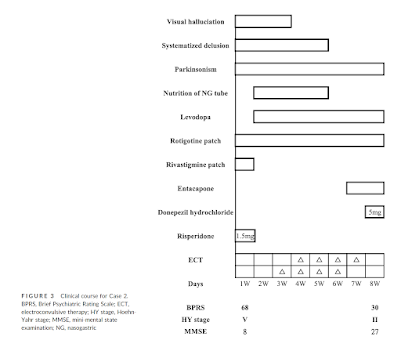ECT For Lewy Body Dementia: New Case Series From Japan
Out on PubMed, from authors in Japan, is this case series:
Electroconvulsive therapy improves psychotic symptoms in patients with dementia with Lewy bodies.
Int J Geriatr Psychiatry. 2022 Nov;37(11). doi: 10.1002/gps.5832.PMID: 36281953

The abstract is copied below:
Purpose: The aim of this study was to examine the efficacy and safety of electroconvulsive therapy (ECT) for psychotic symptoms of dementia with Lewy bodies (DLB), and also to determine its use as an adaptive criterion.
Methods: Eight patients aged 66-83 years old (mean 75.4 ± 5.9 years) diagnosed with probable DLB based on the criteria for DLB and who received ECT between September 2013 and December 2019 at Aichi Medical University were enrolled. The efficacy and safety of ECT were retrospectively examined. Psychotic symptoms were evaluated using the Brief Psychiatric Rating Scale (BPRS), while parkinsonism was evaluated based on Hoehn-Yahr (HY) stage, with both scores analyzed and compared statistically between before and after ECT. Additionally, a follow-up survey after undergoing ECT was performed.
Results: Two incidents occurred during ECT sessions, arrhythmia in one patient and respiratory arrest in another, both of whom quickly recovered. Following ECT, a significant improvement in BPRS score was noted (p < 0.018, Wilcoxon signed rank test), whereas no significant difference was seen in regard to HY stage (p = 0.059). Follow-up survey findings obtained after ECT (mean observation period 15.9 ± 16.7 months), showed that all eight patients were alive and none had a relapse of psychotic symptoms.
Conclusion: The present results suggest that ECT for patients with mild to moderate DLB and drug therapy-resistant psychotic symptoms is safe, well tolerated and effective. We consider it worth considering as a DLB therapeutic option.
Keywords: body mass index; deep venous thrombus; dementia with Lewy bodies; electroconvulsive therapy; psychotic symptoms.
The article is here.
And from the text:

This case series is a welcome addition to the literature on ECT for Parkinson's-related diseases. While the report is flawed in many ways (largely presumably because of language difficulties), it demonstrates antipsychotic efficacy and safety of ECT in these patients with Lewy Body disease and Parkinson's Disease-related dementia. The lack of improvement in motor symptoms of PD is hard to understand (although both patients in the case vignettes seemed to have improved) and the full Hoehn-Yahr ratings are not provided.
All followers of the ECT for Parkinson's Disease literature will want to read this report in full, ~10 minutes.








Comments
Post a Comment